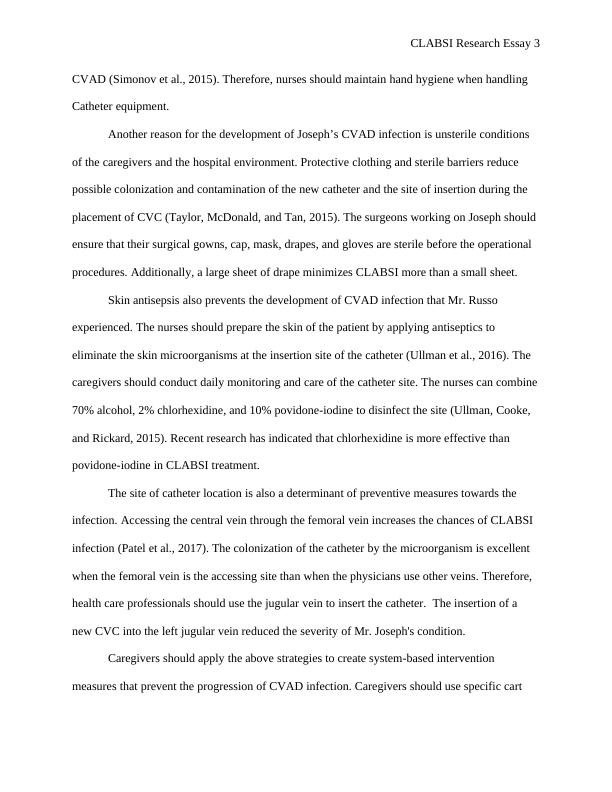Nursing Assignment Case Study
Added on 2020-05-16
9 Pages2423 Words65 Views
CLABSI Research Essay 1CLABSI RESEARCH ESSAYBy [Name]CourseProfessor’s NameInstitutionLocation of InstitutionDate

CLABSI Research Essay 2IntroductionThe case scenario talks about Mr. Joseph Russo who has been diagnosed with Central Line-Associated Bloodstream infection (CLABSI). Mr. Russo’s daughter finds him near his car in an unresponsive state. The patient is not breathing and is hypotensive due to inhalation of carbon monoxide from the car. Emma (the patient's daughter) calls for an ambulance which ferries him to the hospital. The caregivers insert an oropharyngeal airway and Intravenous cannula to provide ventilation for the patient. Additional remedies to correct his condition include the insertion of a central venous catheter (CVC) and IV noradrenaline to normalize the blood pressure. Joseph also experienced symptoms of delirium such as agitation and restlessness.The insertion of CVC into his left internal jugular vein made him develop a CVAD infection. This essay will discuss the prevention and management of CVAD and Occlusion.Prevention of CVAD associated BSIs The diagnosis of Joseph indicated that he had CLABSI which resulted from the insertion of CVC during treatment. The first preventive measure is education to caregivers before they insert the catheter (Alexandrou et al., 2014). The nurses should use a sterile drape which is full-size when inserting a CVC into the system of the patient. The application of sterile drapes reduces the rate of CLABSI in catheter-induced treatments (Ling et al., 2016). The supervisors ofthe nurses should ensure that caregivers apply the clinical rates to reduce the infections.The maintenance of hand hygiene is another essential preventive measure when inserting the catheter. The contamination of the hands of the nurses attending to Joseph would result from the removal of a swab from the peripheral and central blood cultures. Healthcare professionals also acquire contamination from the immediate environment or when attending to other contaminated patients. Improvement in hand hygiene decreases the incidences of BSIs such as

CLABSI Research Essay 3CVAD (Simonov et al., 2015). Therefore, nurses should maintain hand hygiene when handling Catheter equipment.Another reason for the development of Joseph’s CVAD infection is unsterile conditions of the caregivers and the hospital environment. Protective clothing and sterile barriers reduce possible colonization and contamination of the new catheter and the site of insertion during the placement of CVC (Taylor, McDonald, and Tan, 2015). The surgeons working on Joseph should ensure that their surgical gowns, cap, mask, drapes, and gloves are sterile before the operational procedures. Additionally, a large sheet of drape minimizes CLABSI more than a small sheet. Skin antisepsis also prevents the development of CVAD infection that Mr. Russo experienced. The nurses should prepare the skin of the patient by applying antiseptics to eliminate the skin microorganisms at the insertion site of the catheter (Ullman et al., 2016). The caregivers should conduct daily monitoring and care of the catheter site. The nurses can combine70% alcohol, 2% chlorhexidine, and 10% povidone-iodine to disinfect the site (Ullman, Cooke, and Rickard, 2015). Recent research has indicated that chlorhexidine is more effective than povidone-iodine in CLABSI treatment. The site of catheter location is also a determinant of preventive measures towards the infection. Accessing the central vein through the femoral vein increases the chances of CLABSI infection (Patel et al., 2017). The colonization of the catheter by the microorganism is excellent when the femoral vein is the accessing site than when the physicians use other veins. Therefore, health care professionals should use the jugular vein to insert the catheter. The insertion of a new CVC into the left jugular vein reduced the severity of Mr. Joseph's condition.Caregivers should apply the above strategies to create system-based intervention measures that prevent the progression of CVAD infection. Caregivers should use specific cart

End of preview
Want to access all the pages? Upload your documents or become a member.
Related Documents
Healthcare Assignment: Case Study Analysislg...
|8
|2241
|119
Prevention of CVAD (Central Venous Access Device) - PDFlg...
|7
|1554
|271
Chlorhexidine and CVC Line Infection Assignmentlg...
|7
|1518
|167
CNA345 Evidence Based Practice: A Nursing Research Assignmentlg...
|11
|2848
|306
Prevention and Management of Central Line Associated Bloodstream Infection (CLABSI)lg...
|9
|2813
|306
Impact of CVAD on Patient Condition: Infection, Management, and Preventionlg...
|6
|1534
|97
